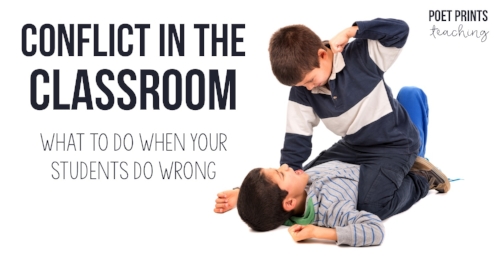Conflict in the Classroom
How often have you just wanted to pull your hair out because the students won’t get along? No classroom is immune from conflict. And conflict comes in all varieties: fights, misbehavior, kids being rude, you name it. How many times have you heard some of these in your classroom:
“He started it!”
“It wasn’t me!”
“Dooonnnn’ttt!”
** eye roll **
“I don’t need to listen to you!”
** budging in line**
“Teacher! He pushed me!”
How many times have you witnessed something like this in your classroom? How often have you just wanted to pull your hair out because the kids won’t get along? No classroom is immune from conflict. And conflict comes in all varieties: fights, misbehavior, kids being rude, you name it. What can we do when our students do something wrong? I’ve had to privilege of working alongside some gifted teachers who have taught me a lot about dealing with conflict and I’ve learned some helpful things along the way as well.
Talk It Out
When given the opportunity, most students are quite articulate. Try to get to the root of the problem and give the student a chance to speak. All too often, the teacher does most of the talking; sometimes it’s important to do most of the listening. Often times, problem behavior comes from something else. Chances are, the students are not acting up because they want to misbehave. Rather, they might be tired, hungry, sad, or a plethora of other reasons. By giving students an opportunity to talk, you feed a positive student-teacher relationship. Through talking and listening, you show your students that you care about their thoughts and feelings.
Give Space
Give your students space to cool down, if necessary. The immediate moment following an incident may not be the best time to debrief. Let the student go for a walk down the hall, or sit outside the door. Some classrooms use a cool down space to give students a safe place to regulate their emotions before they are ready to talk things through. You can find more information about this in my post about anxiety.
Give Perspective
After a student does something wrong, it’s important to help the student see how his or her actions affected others. Young children, especially, are quite self-interested. They do not readily think about cause and effect. Thus, we have a responsibility to teach them how their actions involve others and affect them. Some may come to this realization on their own, others may need help. Perspective can be taught through role-playing, drawing the situation, social stories or a graphic organizer. I use these behavior reflections to help students to reflect on what happened and reach conclusions about how their actions affected others.
Teach Restoration
Students need lessons on how to ‘make it right’ after an incident occurs. In my classroom, after I have talked through an incident with a student, it always ends with an apology and a way to ‘make it right’ with the person that was hurt. A Kindergarten teacher friend teaches her kiddos to say “I’m sorry. What can I do to make it better?” This gives the student who was hurt an opportunity to feel cared for. I’ve also seen teachers encourage students to draw a picture, ask the person to play at lunch, or share a snack with the person (although some schools have strict policies against sharing food). I’ve found that apology letters also work quite well. Plus, this integrates literacy into character building!
Conflict is present in every classroom and in every grade. No classroom is immune. But there are many things that we, as teachers, can do that will help our students build character. If you’ve discovered any tips and tricks that have helped you, feel free to share!
Like this post? Pin it!


